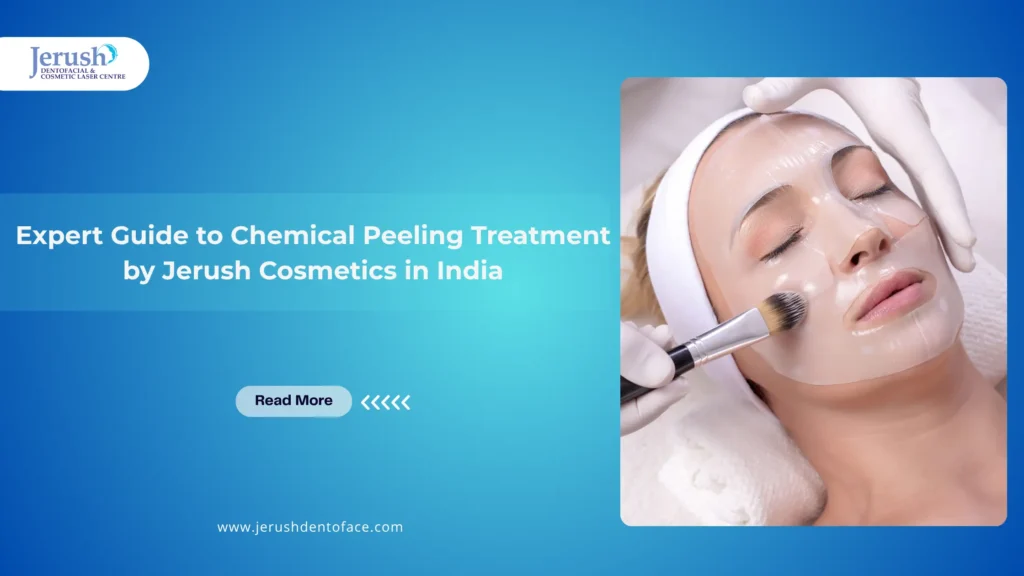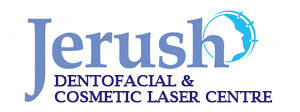
Expert Guide to Chemical Peeling Treatment by Jerush Cosmetics in India
If you wish you could hit the reset button and fix all your skin problems, including acne scars, uneven skin tone, wrinkles, or just tired, dull skin, a chemical peel is what you are looking for.
This treatment helps smooth out fine lines, fades dark spots, and gives you that fresh, radiant glow. Also, it helps boost your skin’s natural regeneration process, making it look younger and healthier.
Isn't it cool?
Whether your dermatologist suggested a chemical peel treatment, your dear friend suggested it, or you are simply intrigued about it, we have you covered.
Let’s dive into how Jerush’s chemical treatments can make that happen for you with their top-notch chemical peeling treatments.
What is a chemical peel treatment?
A chemical peel treatment is a skin-resurfacing procedure that involves applying a chemical solution to the skin.
This solution causes the outer layers of skin to exfoliate and peel off, thus revealing fresh, new skin underneath that's smoother, less wrinkly, and more even-toned.
What does it treat?
Chemical peels are used to treat a variety of skin issues, which include:
- ♦ It reduces the appearance of wrinkles around the eyes, mouth, and forehead.
- ♦ This treatment can unclog pores, reduce acne breakouts, and dull the appearance of acne scars.
- ♦ It can also treat dark patches, sun spots, age spots, and melasma.
- ♦ It not only improves the skin's overall tone and texture but also reverses some of the damage caused by prolonged exposure to the sun, such as sunburns and sunspots.
- ♦ The chemical peels also aid in softening and reducing the appearance of various types of scars, including those from injuries and surgery.
What are the types of chemical peels?
Chemical peels are categorized based on how deeply the peel treatment is done to remove the facial cells.
1. Light chemical peel
Also called superficial peels, this procedure uses mild acids like alpha-hydroxy acids to exfoliate the outer layer of skin gently.
This peel is recommended to treat fine wrinkles, acne, uneven skin tone, and dryness.
The recovery time for this chemical peel type takes some hours to a few days but with little or zero downtime.
You just get a bit of redness and flaking. So, this peel is perfect for fixing minor issues, and it's best to get it every few weeks.
2. Medium chemical peels
As the name suggests, this chemical peel is intended to remove skin cells from the epidermis and from portions of the upper and middle parts of your skin
This is also used to treat wrinkles, acne scars, and uneven skin tone.
3. Deep chemical peel
This chemical peel helps remove skin cells even deeper by using stronger acids.
These peels are used to treat severe skin issues, including deep wrinkles, extensive sun damage and significant scarring.
The deep penetration removes multiple layers of damaged skin cells, promoting significant regeneration and remodeling of the skin's structure.
So, there are different levels of peels, each going deeper into the skin to tackle various issues.
Which one you get depends on how serious your skin problems are and what results you are after.
Looking for cosmetic skin treatments in Nagercoil? Look no further! At Jerushdentoface, we offer cutting-edge solutions tailored to your skin’s needs.
Preparation for the chemical peel
Before you get a chemical peel treatment, your doctor may suggest the following:
- ♦ You shouldn't use any kind of topical retinol cream for at least 48 hours.
- ♦ Avoid waxing, epilating, or using any hair removal products a week before the peel.
- ♦ A week before the chemical peel treatment, avoid using facial scrubs or exfoliants
- ♦ In some cases, your doctor may prescribe a painkiller or sedative, which you must take as prescribed before the treatment.
- ♦ Use a retinoid cream to avert skin darkening and a special lotion to improve treatment outcomes.
- ♦ Avoid tanning or direct sun exposure for two weeks before the treatment.
Book your consultation today with the top cosmetic skin treatments in Adyar, Chennai, at Jerushdentoface.
What does the chemical peel treatment involve?
Before the procedure
A chemical peel treatment is often performed at a doctor's clinic. Before the procedure, the doctor will clean your face, seal your hair, and cover your eyes with either ointment, gauze, tape, or goggles.
Light chemical peels aren't that painful. But if you are getting a medium peel, you might be given a sedative and a painkiller to keep you comfortable.
Deep chemical peels are intense. So you will receive a sedative, a numbing agent for the treatment area.
During the chemical peel treatment procedure
For a light chemical peel treatment
Using a brush or cotton ball, a chemical solution that contains glycolic acid or salicylic acid is applied to your skin.
The treated skin then starts to whiten. You are likely to experience mild stinging while the chemical solution is on your skin.
Next, a neutralizing solution is applied to remove the chemical solution from the treated skin.
For a medium chemical peel
This type of chemical peel involves applying a chemical solution that contains trichloroacetic acid, sometimes in combination with glycolic acid. The treated skin starts to whiten.
Next, cool compresses are applied to soothe the treated skin.
You might be given a hand-held fan to cool your skin. Unlike a light chemical peel, this peel doesn't use a neutralizing solution.
After this chemical peel treatment, you get a stinging and burning feeling for up to 20 minutes. It takes over a week to 14 days to heal.
For a deep chemical peel
This chemical peel is a little more intense than the other two. Cotton dipped in carbolic acid is applied to your skin.
The treated skin starts to turn white or grey. However, to reduce your facial skin's exposure to phenol, this treatment is done at 15-minute intervals. This full-facial procedure takes about 90 minutes.
This type requires a longer recovery time, often a few weeks. So expect a healing time of 14 to 21 days with noticeable redness, swelling, and peeling.
But because they are so intense, you only need them once or twice in your life.
After the chemical peel procedure
After any chemical peel, expect your skin to be red, tight, irritated, or at least swollen. The recovery time varies for each chemical peel type.
After a light peel treatment, your skin will be red, dry, and mildly irritated.
Since only mild chemicals are used and it treats the outer layer, the bruises won't be severe, and you can usually wear makeup the next day.
However, healing takes about one to seven days, and your skin might be temporarily lighter or darker.
After a medium peel treatment, you might witness redness, swelling, and stinging, and it might be recommended to use ice packs and over-the-counter pain relief.
Here, the healing takes about seven to 14 days, though redness can last for months.
As for the deep peel chemical treatment, since it’s an intense treatment, expect severe redness, swelling, burning, and throbbing on your face.
You will need to apply the ointment several times daily for about two weeks to heal the treated area.
It's highly recommended to follow your doctor's advice on sun protection, cleansing, moisturizing, and applying protective ointments.
It might take several months for your skin colour to normalise and for the full results to show.
Can anyone undergo a chemical peel treatment?
Like every skin treatment, this one isn't recommended for some people who
- Have extra coloring in your scars.
- You can't avoid sun exposure during the healing period.
- Have a history of abnormal skin scarring.
- Dealing with skin conditions or taking medications that make your skin more sensitive.
A light chemical peel treatment suits all skin types. As for the medium and deep chemical peel, you must consult your cosmetician or dermatologist.
But here's a warning: people with darker skin tones undergoing this light chemical peel treatment may be affected by a condition called post-inflammatory hyperpigmentation,
which darkens your skin after treatment. This condition is called post-inflammatory hyperpigmentation.
Final Words
Chemical peel treatments can easily treat multiple problems; you can witness fast results, and chemical peel treatment sessions are super-fast.
Remember, the cosmetic skin treatments, your new skin becomes more delicate and susceptible to complications.
If your skin starts to itch, swell, or burn, contact your doctor immediately and strictly avoid scratching, as it can lead to an infection.
To get the best out of your chemical peel treatment, follow these tips: When your skin heals from the treatment, start applying sunscreen and moisturizer daily to keep your skin moist and prevent scarring.
Avoid using a tanning bed or other type of indoor or outdoor tanning when your skin is still in the healing process.
Why settle for anything less than glowing, healthy skin? Get the best cosmetic skin treatments in Chennai at Jerushdentoface. Schedule an appointment with us now!
FAQs
1. How many chemical peel treatments are needed?
The number of chemical peel treatments depends on your skin type, the desired outcome you want to achieve, and the type of chemical peel.
If you desire deep peel treatments, they can last for several years, but individuals who prefer light peels may need to take this treatment every few weeks.
The average time between two sessions has to be 3 to 4 weeks. Again, this can change depending on the downtime and strength of the peel.
2. How is a chemical peel performed?
A chemical solution is applied to the skin, and it is allowed to rest on the skin for 5 minutes, after which it's neutralised and removed.

No Comments yet!